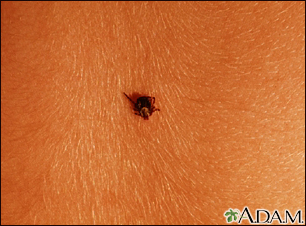
Ticks are small, insect-like creatures that live in forests and fields. They attach to you as you brush past bushes, plants, and grass. Once on you, ticks often move to a warm, moist location. They are often found in the armpits, groin, and hair. Ticks attach firmly to your skin and begin to draw blood for their meal. This process is painless. Most people will not notice the tick bite.
Some species of ticks can be as large as a pencil eraser. They can also be so small that they are very hard to see. They grow in size (engorgement) after attachment. Ticks can transmit bacteria that can cause disease. Some of these can be serious. However, it usually requires several hours after the tick attaches to transmit bacteria efficiently. So, it is important to remove ticks as soon as possible after they have become attached to avoid this transmission.



While most ticks do not carry bacteria that cause human diseases, some ticks do carry these bacteria. These bacteria can cause:
If a tick is attached to you, follow these steps to remove it:
Contact your provider if you have not been able to remove the entire tick. Also contact in the days following a tick bite if you develop:
Call 911 or the local emergency number if you have any signs of:
To prevent tick bites:
After returning home:
Bolgiano EB, Sexton J. Tickborne illnesses. In: Walls RM, ed. Rosen's Emergency Medicine: Concepts and Clinical Practice. 10th ed. Philadelphia, PA: Elsevier; 2023:chap 123.
Cummins GA, Traub SJ. Tick-borne diseases. In: Auerbach PS, Cushing TA, Harris NS, eds. Auerbach's Wilderness Medicine. 7th ed. Philadelphia, PA: Elsevier; 2017:chap 42.
Diaz JH. Ticks, including tick paralysis. In: Bennett JE, Dolin R, Blaser MJ, eds. Mandell, Douglas, and Bennett's Principles and Practice of Infectious Diseases. 9th ed. Philadelphia, PA: Elsevier; 2020:chap 296.
BACK TO TOPReview Date: 2/5/2025
Reviewed By: Jatin M. Vyas, MD, PhD, Roy and Diana Vagelos Professor in Medicine, Columbia University Vagelos College of Physicians and Surgeons, Division of Infectious Diseases, Department of Medicine, New York, NY. Also reviewed by David C. Dugdale, MD, Medical Director, Brenda Conaway, Editorial Director, and the A.D.A.M. Editorial team.

|
A.D.A.M., Inc. is accredited by URAC, also known as the American Accreditation HealthCare Commission (www.urac.org). URAC's accreditation program is an independent audit to verify that A.D.A.M. follows rigorous standards of quality and accountability. A.D.A.M. is among the first to achieve this important distinction for online health information and services. Learn more about A.D.A.M.'s editorial policy, editorial process and privacy policy. A.D.A.M. is also a founding member of Hi-Ethics and subscribes to the principles of the Health on the Net Foundation (www.hon.ch). |
The information provided herein should not be used during any medical emergency or for the diagnosis or treatment of any medical condition. A licensed medical professional should be consulted for diagnosis and treatment of any and all medical conditions. Call 911 for all medical emergencies. Links to other sites are provided for information only -- they do not constitute endorsements of those other sites. © 1997- A.D.A.M., Inc. Any duplication or distribution of the information contained herein is strictly prohibited.